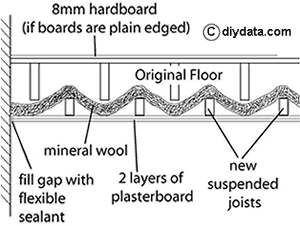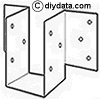Suspended ceiling to soundproof a floor
Alternative methodThis alternative method for fitted a sound proofing suspended floor, has a number of advantages over the first method described.
- Slightly less head room is lost from the room;
- The insulation covers the whole of the ceiling structure so noise deadening is slightly increased;
- The insulation quilt is run at right angles to the new joist so is easier to put into place during installation.
 The
alternative method for fitting a sound proofing suspended ceiling is shown to the right. The maximum span of room for this method is again 5 to 7 metres.
The
alternative method for fitting a sound proofing suspended ceiling is shown to the right. The maximum span of room for this method is again 5 to 7 metres.
The new suspended joists are run between the joists of the floor above and fixed to the wall using wall hangers. Mineral wool is fitted over the new joists and under the existing joists - two layers of plasterboard are fixed to the underside of the new joists. If the floorboards in the room above are plain edged (rather than tongued and grooved), the floor should be covered with 6/8mm hardboard.
Fitting a sound proofing suspended ceiling.
- The first thing to do is to remove the existing ceiling, disconnecting (after isolating the electrical supply) ceiling fixtures (lights etc) as you work across the room. Clean up the bottom of the joists, removing all nails etc.
- Next work out the position of the bottom of the hangers for the new joists, this needs to be on a line which is at least 25mm below the bottom of the existing joists plus the nominal thickness of the mineral wool - a greater distance will make it easier to install the mineral wool. If services (central heating etc) run in the space between joists, you may need to lower the new joists to leave enough room for the mineral wool.
- Once the distance has been determined, it can be easily marked by using a laser level under the joists.
If a laser level is not available, measure down under each of the end joists the required distance.  Start
in between a pair of existing end joists, position and fix a joist hanger (right) the required distances below the joists and mid way between them. Moving to the other end of the pair of joists, mark the position for the hanger at that end of the room, again the required distances below the joists and mid way between them. As you won't be able to drop the joist in from above, lift the new joist into place and fit the second joist hanger - you may find it easier to drill and plug the holes in the wall and then screw the joist hanger in place.
Start
in between a pair of existing end joists, position and fix a joist hanger (right) the required distances below the joists and mid way between them. Moving to the other end of the pair of joists, mark the position for the hanger at that end of the room, again the required distances below the joists and mid way between them. As you won't be able to drop the joist in from above, lift the new joist into place and fit the second joist hanger - you may find it easier to drill and plug the holes in the wall and then screw the joist hanger in place.
Secure the end of the joist to the hanger using nails or screws.- Moving to the other end of the room, fit the end joist in a similar manner between the two existing end joists.
- With the two end joists in place, run a string line between the undersides of the joist hangers on each wall.
- Work along from one end of the room and fit each sequential joist in the same manner as the end joists in between each pair of existing joists, carefully line up the bottom of each hanger with the string line.
Mark the wall under the centre of each joist hanger - this will help you find the joists when you come to secure the plasterboard to them. - Arrange for any ceiling fixtures which need to be positioned in the suspended ceiling.
- The mineral wool needs to be in place before the ceiling is boarded. Working from one end of the room, 'weave' the mineral wool across the room, over the new joists and under the existing ones. Leave enough material at each end so that when the plasterboard is installed, the mineral wool will reach the end wall. Make sure that the edge of each piece of mineral wool is tightly fitted against the wall or adjacent piece. Remember where you need to drop any electrical wiring through the mineral wool.
- Fit and secure (using drywall screws) the first layer of plasterboard under the joists/mineral wool. Leave a gap of about 5mm between the edges of the plasterboard and the walls - the walls may be uneven, 5mm should be considered the minimum gap. As a second layer of plasterboard is going to be installed, place the first screw on each joist about 300mm from one wall and space the remainder at about 300mm centres.
- Remember where you need to drop any electrical wiring through the plasterboard and make holes through the plasterboard as necessary.
- Install the second layer of plasterboard using longer screws and place the first screw on each joist about 150mm from the wall and space the remainder at about 300mm centres. Ensure that the edges of the second layer of plasterboard do not line up with those of the first layer. Ensure that the edge gap is still maintained and don't forget to drop through any electrical cables required.
- When the second layer of plasterboard is in place, fill the edge gaps using a flexible sealant.
- To finish off the corners of the ceiling, fit either plain or paper covered polystyrene coving rather than plaster coving - this will reduce any vibrations being conveyed from the walls to the ceiling.
- Fit any ceiling fixtures to the ceiling as appropriate.
- Finish the ceiling by skimming, papering or applying a decorative coating to suit your tastes.
The new suspended ceiling is now complete.
The floor above
If the floor in the room above has plain edged floorboard (rather than tongued and grooved), it should be covered in 6 or 8mm exterior grade hardboard (smooth side up). Secure the sheets at 150 mm (6 inch) centres all over the sheets using annular ring nails to reduce the possibility of the nails working up. The sheets should be dampened 24 hours before installation so that they can be laid flat and this should prevent subsequent unevenness.
The soundproofing is now complete, ideally the floor above should be covered with carpet using a heavy duty underlay to further improve the noise deadening characteristics of the floor.
